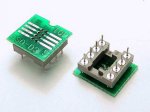westaust55
Moderator
Like the good Dr, Acula, I have seen references on this forum suggesting that if there is one slow (100kHz) component on the i2c bus then the the bus is forced to always run at the slow speed.
Well thinking about what I and others (may) have on their i2c buses and the speeds of these devices:
1. DS1307 RTC = slow (I have a separate RTC as well as in the AXE033)
2. AXE033 LCD = slow
3. PCF8574 IO Expander = slow ( couple in my case )
4. 24LC256 EEPROM = fast (several added in my case)
a few things others have mentioned:
5. MCP23016/7 IO Expander = fast
6. MCP23008 IO Expander . . = fast
7. SRF08 U/S Range finder . = fast
8. CMPS03 Compass module = fast
9. SP03 Speech Syn Module = fast
Also noted of general interest from BCJKiwi code snipped that:
1. many people have a slow devices in the form of an DS1307 RTC or an AXE033 and a few out ther also some have PCF8574 IO Expanders.
2. most other devices appear to be fast (400kHz) bus speed.
I for one currently have items type 1, 3 and 4 so a mix of slow and fast devices and no problems experienced to date.
Maybe some erudite peron can point at a specific i2c spec or datasheet that indicates problems WILL be experienced.
Well thinking about what I and others (may) have on their i2c buses and the speeds of these devices:
1. DS1307 RTC = slow (I have a separate RTC as well as in the AXE033)
2. AXE033 LCD = slow
3. PCF8574 IO Expander = slow ( couple in my case )
4. 24LC256 EEPROM = fast (several added in my case)
a few things others have mentioned:
5. MCP23016/7 IO Expander = fast
6. MCP23008 IO Expander . . = fast
7. SRF08 U/S Range finder . = fast
8. CMPS03 Compass module = fast
9. SP03 Speech Syn Module = fast
Also noted of general interest from BCJKiwi code snipped that:
So in conclusion,if the CMPS03 is wired to the i2c bus but not powered up (i.e. v+ disconnected), it 'kills' the i2c bus. So if you are working with a CMPS03, ensure it is fully connected and powered up, or, disconnect it from the bus at the preceding device - i.e. no floating wires. Other devices (e.g. DS1307) did not exhibit this behaviour.
1. many people have a slow devices in the form of an DS1307 RTC or an AXE033 and a few out ther also some have PCF8574 IO Expanders.
2. most other devices appear to be fast (400kHz) bus speed.
I for one currently have items type 1, 3 and 4 so a mix of slow and fast devices and no problems experienced to date.
Maybe some erudite peron can point at a specific i2c spec or datasheet that indicates problems WILL be experienced.
Last edited:


